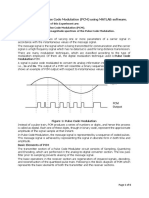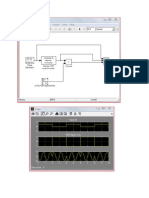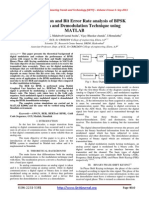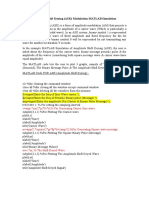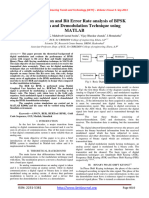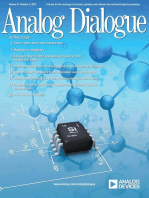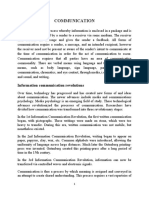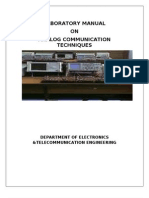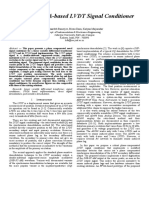PSK Lab Manual
PSK Lab Manual
Uploaded by
Sakshi DewadeCopyright:
Available Formats
PSK Lab Manual
PSK Lab Manual
Uploaded by
Sakshi DewadeCopyright
Available Formats
Share this document
Did you find this document useful?
Is this content inappropriate?
Copyright:
Available Formats
PSK Lab Manual
PSK Lab Manual
Uploaded by
Sakshi DewadeCopyright:
Available Formats
EXPERIMENT NO:
Aim: To Study Phase Shift Keying on Matlab
Apparatus: Matlab Software
Theory: PSK is the digital modulation technique in which the phase of the carrier signal is
changed by varying the sine and cosine inputs at a particular time. PSK technique is widely
used for wireless LANs, bio-metric, contactless operations, along with RFID and Bluetooth
communications.
BPSK Modulator
The block diagram of Binary Phase Shift Keying consists of the balance modulator which has
the carrier sine wave as one input and the binary sequence as the other input. Following is the
diagrammatic representation.
The modulation of BPSK is done using a balance modulator, which multiplies the two signals
applied at the input. For a zero binary input, the phase will be 0° and for a high input, the
phase reversal is of 180°.
Following is the diagrammatic representation of BPSK Modulated output wave along with its
given input.
Department of Electronics and Communication Engineering DCOM Lab
The output sine wave of the modulator will be the direct input carrier or the inverted
180°phaseshifted input carrier, which is a function of the data signal.
BPSK Demodulator
The block diagram of BPSK demodulator consists of a mixer with local oscillator circuit, a
bandpass filter, a two-input detector circuit. The diagram is as follows.
Department of Electronics and Communication Engineering DCOM Lab
By recovering the band-limited message signal, with the help of the mixer circuit and the
band pass filter, the first stage of demodulation gets completed. The base band signal which
is band limited is obtained and this signal is used to regenerate the binary message bit stream.
In the next stage of demodulation, the bit clock rate is needed at the detector circuit to
produce the original binary message signal. If the bit rate is a sub-multiple of the carrier
frequency, then the bit clock regeneration is simplified. To make the circuit easily
understandable, a decision-making circuit may also be inserted at the 2nd stage of detection.
Procedure: 1. Open Matlab Software
2. Click on New Script and Start to write a Program
3. After wrote Save and Run Program
4. Command Window will open
5. Give the Following Input to generate PSK modulated wave.
6. Enter frequency of Carrier Sine wave: 60
7. Enter Message frequency: 10
8. Enter Carrier & Message Amplitude (Assuming Both Equal):3
Circuit Diagram/Block Diagram/Flow chart/Program:
clc %for clearing the command window
close all %for closing all the window except command window
clear all %for deleting all the variables from the memory
t=0:.001:1; % For setting the sampling interval
fc=input('Enter frequency of Carrier Sine wave: ');
fm=input('Enter Message frequency : ');
amp=input('Enter Carrier & Message Amplitude(Assuming Both Equal):');
c=amp.*sin(2*pi*fc*t);% Generating Carrier Sine
subplot(3,1,1) %For Plotting The Carrier wave
plot(t,c)
xlabel('Time')
ylabel('Amplitude')
title('Carrier')
m=square(2*pi*fm*t);% For Plotting Message signal
subplot(3,1,2)
plot(t,m)
xlabel('time')
ylabel('ampmplitude')
title('Message Signal')% Sine wave multiplied with square wave in order to
generate PSK
x=c.*m;
subplot(3,1,3) % For Plotting PSK (Phase Shift Keyed) signal
plot(t,x)
xlabel('t')
ylabel('y')
title('PSK')
Department of Electronics and Communication Engineering DCOM Lab
Results:
Conclusion: Hence we studied Phase Shift Keying successfully on Matlab
Software
Viva questions:
1. What does Phase Shift Keying means?
2. Why PSK is preferred in many application?
3. What are the application of PSK?
Department of Electronics and Communication Engineering DCOM Lab
You might also like
- Exp 6Document9 pagesExp 6Mei Qii100% (1)
- Digital Signal Processing With Mathlab Examples, Vol 1Document649 pagesDigital Signal Processing With Mathlab Examples, Vol 1Toti Caceres100% (3)
- FSK Lab ManualDocument5 pagesFSK Lab ManualSakshi DewadeNo ratings yet
- PCM Lab ManualDocument5 pagesPCM Lab ManualSakshi DewadeNo ratings yet
- Pulse Code Modulation PC MM at Lab CodeDocument6 pagesPulse Code Modulation PC MM at Lab CodealeenhattaNo ratings yet
- DC 1Document61 pagesDC 1Aishwarya GNo ratings yet
- RohitDocument6 pagesRohitRohit YadavNo ratings yet
- Communication Systems Ii - LabmanualDocument12 pagesCommunication Systems Ii - LabmanualpramodNo ratings yet
- Eecb351-Exp 6 PCMDocument5 pagesEecb351-Exp 6 PCMzawirNo ratings yet
- Wicomm T QPSKDocument13 pagesWicomm T QPSKvithyaNo ratings yet
- Communication ManualDocument47 pagesCommunication ManualAbinav anilNo ratings yet
- Implementation and Bit Error Rate Analysis of BPSK Modulation and Demodulation Technique Using MATLABDocument5 pagesImplementation and Bit Error Rate Analysis of BPSK Modulation and Demodulation Technique Using MATLABseventhsensegroup100% (1)
- EXP 9 - Pulse Code Modulation & DemodulationDocument5 pagesEXP 9 - Pulse Code Modulation & DemodulationsasankflyNo ratings yet
- Bapatla Engineering College Digital Communications Lab EC-451Document30 pagesBapatla Engineering College Digital Communications Lab EC-451nithyamnvNo ratings yet
- Implementation and Bit Error Rate Analysis of BPSK Modulation and Demodulation Technique Using MatlabDocument5 pagesImplementation and Bit Error Rate Analysis of BPSK Modulation and Demodulation Technique Using MatlabHayatun NufusNo ratings yet
- Lab 3 ౼ Communication Systems Simulation Using MATLABDocument5 pagesLab 3 ౼ Communication Systems Simulation Using MATLABmaenfadelNo ratings yet
- Lab 3 ౼ Communication Systems Simulation Using MATLAB: 1. Before the StartDocument5 pagesLab 3 ౼ Communication Systems Simulation Using MATLAB: 1. Before the StartKishore KrishnanNo ratings yet
- ModulationPaper ACIQR-3Document85 pagesModulationPaper ACIQR-3Ryan AnchetaNo ratings yet
- Kscom11 PskDocument6 pagesKscom11 PskKalpana ScientificNo ratings yet
- 15EC306J Cycle 2 ExptsDocument28 pages15EC306J Cycle 2 ExptsSanjeev KumarNo ratings yet
- Electronics & Communication EngineeringDocument41 pagesElectronics & Communication EngineeringKrishna Chaitanya TNo ratings yet
- Telecom - Exp - 10 - QAM, MSK, & GMSKDocument15 pagesTelecom - Exp - 10 - QAM, MSK, & GMSKrakibNo ratings yet
- Digital-to-Analog Converter Subsystem: Team Johnny BravoDocument16 pagesDigital-to-Analog Converter Subsystem: Team Johnny BravoGonghao SunNo ratings yet
- Laboratory Record: Experiment No: 06Document7 pagesLaboratory Record: Experiment No: 06Subhashree DashNo ratings yet
- Commn Systems Lab ManualDocument37 pagesCommn Systems Lab Manualnidheeshlal10No ratings yet
- DC Manual Final PDFDocument25 pagesDC Manual Final PDFAsma FirdouseNo ratings yet
- Digital Communications: Lab Manual (Student Copy)Document78 pagesDigital Communications: Lab Manual (Student Copy)dhileepan DilipNo ratings yet
- Digital Modulation Technique (U-2)Document82 pagesDigital Modulation Technique (U-2)lakshmikanth gNo ratings yet
- Digital Modulation TechniquesDocument37 pagesDigital Modulation Techniquesmurtessaahmed9No ratings yet
- Cycle 2 Adc 18tel67Document31 pagesCycle 2 Adc 18tel67LitlatohNo ratings yet
- Amplitude Shift Keying (ASK) Modulation MATLAB Simulation: C Amp. Sin (2 Pi FC T) % For Generating Carrier Sine WaveDocument6 pagesAmplitude Shift Keying (ASK) Modulation MATLAB Simulation: C Amp. Sin (2 Pi FC T) % For Generating Carrier Sine WaveAbdullah Al Mamun ParvezNo ratings yet
- Frequency Shifte Keying: University of Nineveh Electronic EngineeringDocument7 pagesFrequency Shifte Keying: University of Nineveh Electronic Engineeringismail / اسماعيلNo ratings yet
- CDMA Baseband Processing On A TMS320C54x DSPDocument11 pagesCDMA Baseband Processing On A TMS320C54x DSPsampath5211No ratings yet
- WTM Microwave DigitalDocument16 pagesWTM Microwave DigitalrrohuuNo ratings yet
- CEE 312 Experiment 5: Binary Phase Shift Keying (BPSK)Document4 pagesCEE 312 Experiment 5: Binary Phase Shift Keying (BPSK)Hayatun NufusNo ratings yet
- Lab 5 BPSK - Binary Phase Shift KeyingDocument5 pagesLab 5 BPSK - Binary Phase Shift KeyingNo_pidas_CCH_ni_prepa_unamNo ratings yet
- Ijett V4i9p160Document5 pagesIjett V4i9p160kuzhaloliNo ratings yet
- Frequency Shift Keying FSKDocument10 pagesFrequency Shift Keying FSKapi-19937584No ratings yet
- DC Lab ManualDocument24 pagesDC Lab Manualvidyae100% (2)
- CommSim File YoyoDocument20 pagesCommSim File YoyoAnshul GuptaNo ratings yet
- A Novel Approach For High Speed Multimedia Compression Using 64 Bit Quadrature Amplitude Modulator/DemodulatorDocument7 pagesA Novel Approach For High Speed Multimedia Compression Using 64 Bit Quadrature Amplitude Modulator/DemodulatoreditorinchiefijcsNo ratings yet
- Matlab Part 1Document16 pagesMatlab Part 1rajaranjayNo ratings yet
- DC - Experiment - No. 5Document8 pagesDC - Experiment - No. 5amol maliNo ratings yet
- Surya - First PhasereportDocument10 pagesSurya - First PhasereportSuribabuIppiliNo ratings yet
- DC Lab ManualDocument43 pagesDC Lab ManualSowmya KharviNo ratings yet
- Fundamentals of Microwave Frequency Counters: Application Note 200-1Document20 pagesFundamentals of Microwave Frequency Counters: Application Note 200-1Darshan PatelNo ratings yet
- Lab-8 BPSK Modulation and DemodulationDocument11 pagesLab-8 BPSK Modulation and DemodulationNima Vahidian BaraniNo ratings yet
- DC - Experiment - No. 4Document9 pagesDC - Experiment - No. 4amol maliNo ratings yet
- EC 2301 Digital Communication Unit I and II Question BankDocument63 pagesEC 2301 Digital Communication Unit I and II Question Bankgayathri nathNo ratings yet
- Hardware and Software Co-Simulation of BPSK Modulation and DemodulationDocument7 pagesHardware and Software Co-Simulation of BPSK Modulation and DemodulationseventhsensegroupNo ratings yet
- Digital Signal Processing Using the ARM Cortex M4From EverandDigital Signal Processing Using the ARM Cortex M4Rating: 1 out of 5 stars1/5 (1)
- Reference Guide To Useful Electronic Circuits And Circuit Design Techniques - Part 2From EverandReference Guide To Useful Electronic Circuits And Circuit Design Techniques - Part 2No ratings yet
- Power Systems-On-Chip: Practical Aspects of DesignFrom EverandPower Systems-On-Chip: Practical Aspects of DesignBruno AllardNo ratings yet
- Analog Dialogue, Volume 48, Number 1: Analog Dialogue, #13From EverandAnalog Dialogue, Volume 48, Number 1: Analog Dialogue, #13Rating: 4 out of 5 stars4/5 (1)
- Reference Guide To Useful Electronic Circuits And Circuit Design Techniques - Part 1From EverandReference Guide To Useful Electronic Circuits And Circuit Design Techniques - Part 1Rating: 2.5 out of 5 stars2.5/5 (3)
- High-Performance D/A-Converters: Application to Digital TransceiversFrom EverandHigh-Performance D/A-Converters: Application to Digital TransceiversNo ratings yet
- Analysis and Design of Multicell DC/DC Converters Using Vectorized ModelsFrom EverandAnalysis and Design of Multicell DC/DC Converters Using Vectorized ModelsNo ratings yet
- Lesson 1Document12 pagesLesson 1Kean Rafael MarianoNo ratings yet
- Communication Electronic 2 Edition - Frenzel ©2008 Created by Kai Raimi - BHCDocument24 pagesCommunication Electronic 2 Edition - Frenzel ©2008 Created by Kai Raimi - BHCGmae FampulmeNo ratings yet
- Elements of Communication SystemDocument31 pagesElements of Communication SystemsujithNo ratings yet
- Analog & Imaging IC Logic LSI: Semiconductor & Storage ProductsDocument28 pagesAnalog & Imaging IC Logic LSI: Semiconductor & Storage ProductsOlivier López ChNo ratings yet
- Unit 2 - CT2Document45 pagesUnit 2 - CT2Jagrit DusejaNo ratings yet
- E Item 3MCM24-21C-E-BT-0Document1 pageE Item 3MCM24-21C-E-BT-0lusoegyi 1919No ratings yet
- Digital Switching Systems Notes PDFDocument119 pagesDigital Switching Systems Notes PDFChandra PrakashNo ratings yet
- MCQ in Communications by Alejamdro H. Ballado, Jr.Document51 pagesMCQ in Communications by Alejamdro H. Ballado, Jr.Ismaela CatipayNo ratings yet
- B.flt.8009 Technical AssessmentDocument75 pagesB.flt.8009 Technical AssessmentKaveewatNo ratings yet
- Communication: Communication Is A Process Whereby Information Is Enclosed in A Package and IsDocument52 pagesCommunication: Communication Is A Process Whereby Information Is Enclosed in A Package and IsreubanrajNo ratings yet
- Ptu Syllabus For Bath 2011 OnwardsDocument34 pagesPtu Syllabus For Bath 2011 Onwardsjassi7010No ratings yet
- Laboratory Manual On Analog Communication Techniques (2003)Document31 pagesLaboratory Manual On Analog Communication Techniques (2003)Chandra MohantyNo ratings yet
- Telecommunication Technologies: Digital and Analogue Modulation QuantisationDocument66 pagesTelecommunication Technologies: Digital and Analogue Modulation QuantisationAlwi Saladin HNo ratings yet
- NAB ATSC 3.0 Guide - FinalDocument44 pagesNAB ATSC 3.0 Guide - FinalAldo CugniniNo ratings yet
- Performance Analysis of DCO-OfDM in VLC SystemDocument6 pagesPerformance Analysis of DCO-OfDM in VLC SystemayadmanNo ratings yet
- GaddaDocument119 pagesGaddaMurthyNo ratings yet
- Experiment Topic: AM Modulator: 3.1: Curriculum ObjectivesDocument14 pagesExperiment Topic: AM Modulator: 3.1: Curriculum ObjectivesBENSON MAKWABANo ratings yet
- Digital Communication Frequency Shift KeyingDocument3 pagesDigital Communication Frequency Shift KeyingVasu JainNo ratings yet
- Ac Lab Manual Using MatlabDocument62 pagesAc Lab Manual Using MatlabNarasimha KorraNo ratings yet
- Pulse ModulationDocument9 pagesPulse Modulationجلال عواد كاظم جودةNo ratings yet
- A Novel FPGA-based LVDT Signal Conditioner: Kumardeb Banerjee, Bivas Dam, Kalyan MajumdarDocument6 pagesA Novel FPGA-based LVDT Signal Conditioner: Kumardeb Banerjee, Bivas Dam, Kalyan MajumdarnarayanNo ratings yet
- GMSK Modulation: February 2016Document18 pagesGMSK Modulation: February 2016Quỳnh Lê CôngNo ratings yet
- Comparison of 8-QAM, 16-QAM, 32-QAM, 64-QAM 128-QAM, 256-QAM, Etc - Radio-ElectronicsDocument5 pagesComparison of 8-QAM, 16-QAM, 32-QAM, 64-QAM 128-QAM, 256-QAM, Etc - Radio-ElectronicsSovannarith HoyNo ratings yet
- CBSE UGC NET Electronic Science Syllabus PDFDocument3 pagesCBSE UGC NET Electronic Science Syllabus PDFPiyush ShrivastavaNo ratings yet
- Preliminary Plan and Design Assessment Report (Final)Document25 pagesPreliminary Plan and Design Assessment Report (Final)Muhammad SubhanNo ratings yet
- 300 KHZ 2 K 1LzDocument7 pages300 KHZ 2 K 1LzAj TVNo ratings yet
- Opto Electronics Lab ManualDocument45 pagesOpto Electronics Lab Manualminialan07No ratings yet
- Eee 312 8Document3 pagesEee 312 8sabitavabiNo ratings yet
- SFG-205 SFG-210Document9 pagesSFG-205 SFG-210Andreea ShalidaNo ratings yet




